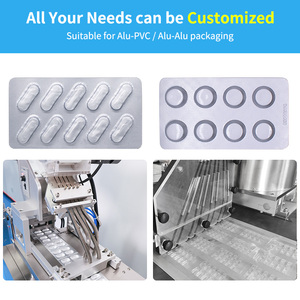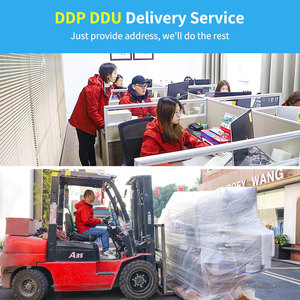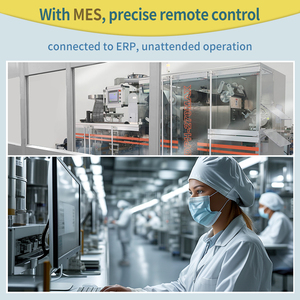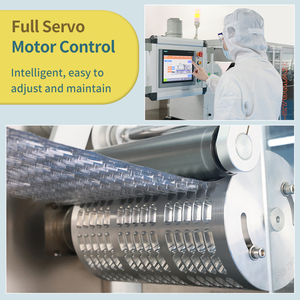
All categories
Featured selections
Trade Assurance
Buyer Central
Help Center
Get the app
Become a supplier

(994 products available)




























blister packaging machine suppliers supplier.html are a vital component in the packaging industry, specifically designed to create secure and tamper-proof packaging for various products. These machines utilize a process that involves heating and forming plastic materials into blister packs that encase items, providing visibility and protection. With the growing demand for efficient and reliable packaging solutions, blister packaging machine suppliers supplier.html have become indispensable in industries ranging from pharmaceuticals to consumer electronics. Their ability to produce uniform and high-quality packaging makes them an essential asset for manufacturers aiming to enhance product presentation and safety.
There are several types of blister packaging machine suppliers supplier.html available in the market, each catering to specific packaging needs. Thermoforming machines are the most common, using heat and vacuum to mold plastic sheets into blister packs. These machines are ideal for high-volume production and can handle a wide range of materials. Cold forming machines, on the other hand, do not require heat and are suitable for sensitive products that may be affected by high temperatures. Rotary machines offer continuous motion and are preferred for their speed and efficiency in mass production. Each type of blister packaging machine suppliers supplier.html is designed to meet unique industry requirements, ensuring optimal performance and quality.
blister packaging machine suppliers supplier.html are equipped with advanced features that enhance their functionality and efficiency. One of the primary functions is to create a secure seal that protects the contents from environmental factors such as moisture and contamination. These machines often feature precision heat controls, ensuring consistent sealing quality across all packs. Automation capabilities, such as programmable logic controllers (PLCs), allow for easy operation and customization of the packaging process. Additionally, many blister packaging machine suppliers supplier.html come with integrated inspection systems that ensure the integrity of each package, reducing the risk of errors and defects. These features not only improve production efficiency but also enhance the overall quality and reliability of the packaging.
The effectiveness of blister packaging machine suppliers supplier.html largely depends on the materials used in the packaging process. Common materials include PVC (polyvinyl chloride), PET (polyethylene terephthalate), and aluminum. PVC is widely used due to its clarity and durability, making it ideal for displaying products. PET is preferred for its recyclability and strength, offering a more environmentally friendly option. Aluminum is often used in cold forming applications, providing a robust barrier against light and moisture. The choice of material affects the machine's settings and the final product's quality, making it crucial for manufacturers to select the appropriate materials for their specific needs. With advancements in material technology, blister packaging machine suppliers supplier.html continue to evolve, offering more sustainable and efficient packaging solutions.
Operating blister packaging machine suppliers supplier.html requires an understanding of their various components and settings to maximize efficiency and output. The first step is setting up the machine with the appropriate materials and adjusting the temperature and pressure settings according to the specifications of the packaging material. Operators must ensure that the machine is calibrated correctly to prevent errors during the production process. Regular maintenance and cleaning are essential to keep blister packaging machine suppliers supplier.html functioning optimally, reducing downtime and prolonging the machine's lifespan. Training operators on the latest technologies and features can significantly enhance productivity and ensure the quality of the packaged products. By following best practices and maintaining the equipment, manufacturers can achieve consistent results and meet the demands of their production lines.
Choosing the right blister packaging machine suppliers supplier.html for your production needs involves several key considerations. First, assess the volume of production and the specific requirements of the products you intend to package. High-volume production lines may benefit from thermoforming machines due to their speed and efficiency, while smaller batches or sensitive products might require cold forming machines. Additionally, the choice of materials, such as PVC or PET, can impact the selection process, as different machines may be optimized for specific material types. Understanding the compatibility of the machine with your intended materials is crucial for achieving optimal packaging results.
Another important factor is the level of automation required. Modern blister packaging machine suppliers supplier.html offer varying degrees of automation, from semi-automatic systems that require operator intervention to fully automated systems that streamline the entire packaging process. The degree of automation should align with your production goals and labor resources. For businesses looking to minimize manual labor and increase throughput, investing in machines with advanced automation features can be beneficial. Moreover, consider the space available in your facility, as larger machines may require more room, while compact models can fit into smaller spaces without compromising efficiency.
Regular maintenance of blister packaging machine suppliers supplier.html is essential to ensure their longevity and optimal performance. This includes routine cleaning to prevent the buildup of residues and dust, which can affect the machine's operation. Lubricating moving parts and checking for wear and tear are also crucial. Periodic inspections by trained technicians can help identify potential issues before they lead to significant downtime. Adhering to the manufacturer's maintenance schedule and guidelines can greatly enhance the machine's reliability.
Product safety is a primary concern when using blister packaging machine suppliers supplier.html . Manufacturers can ensure safety by utilizing machines equipped with precision heat controls and integrated inspection systems. These features help create airtight seals and verify the integrity of each package, reducing contamination risks. Additionally, selecting the appropriate materials that provide robust barriers against environmental factors is vital. Regular testing of packaging samples for durability and seal strength can further assure product safety.
Yes, there are eco-friendly options available for blister packaging machine suppliers supplier.html . Manufacturers are increasingly adopting sustainable practices by using recyclable and biodegradable materials, such as PET and PLA, in their packaging processes. Furthermore, advancements in machine technology have led to more energy-efficient models that reduce power consumption. By choosing machines that support sustainable materials and practices, manufacturers can contribute to reducing their environmental footprint while maintaining high packaging standards.
Operating blister packaging machine suppliers supplier.html can present several challenges, including machine calibration and material compatibility. Ensuring proper calibration of settings such as temperature and pressure is crucial to avoid packaging defects. Additionally, selecting materials that are compatible with the machine's capabilities can prevent operational issues. Operators must have adequate training to troubleshoot and adjust settings as needed. Regular monitoring and quality checks are important to maintain consistent output and address any anomalies promptly.
To optimize the efficiency of blister packaging machine suppliers supplier.html , manufacturers can implement several strategies. Investing in machines with advanced automation features can significantly reduce cycle times and labor costs. Efficient layout and organization of the production line can also enhance workflow and minimize bottlenecks. Regular maintenance and timely upgrades to the machine's software or hardware can improve performance. Additionally, analyzing production data to identify areas for improvement can help refine processes and increase overall efficiency.